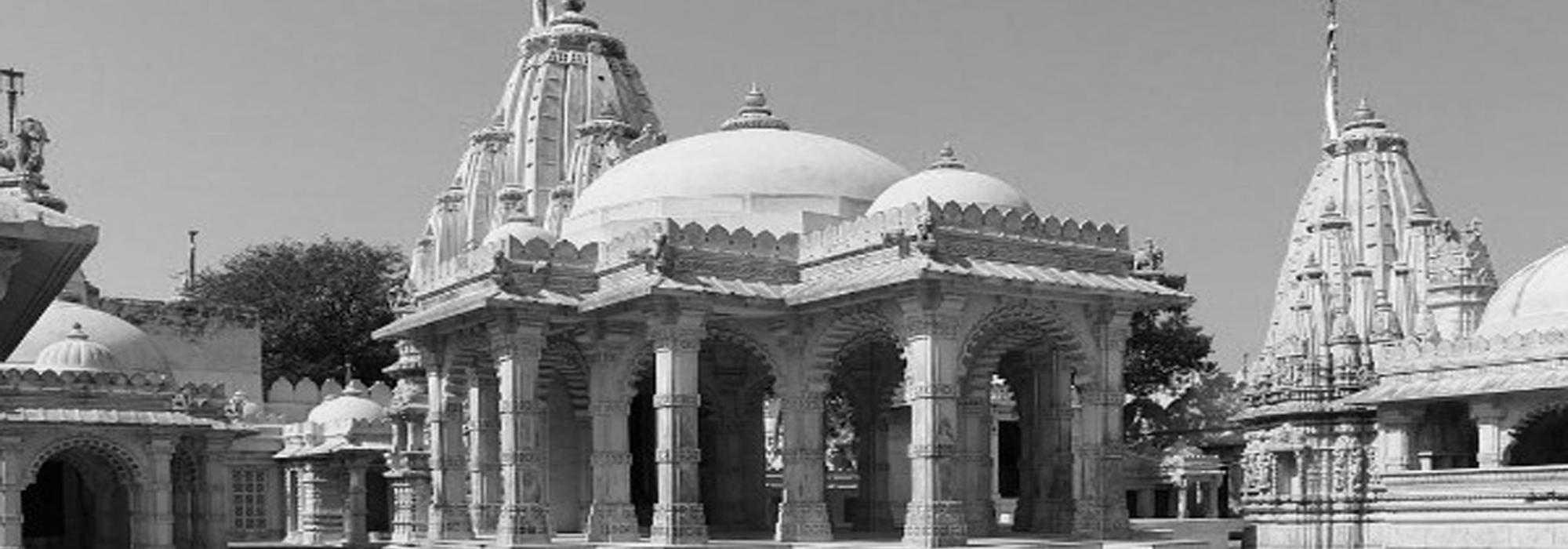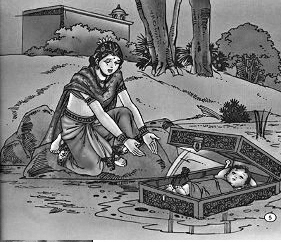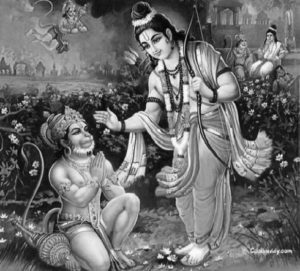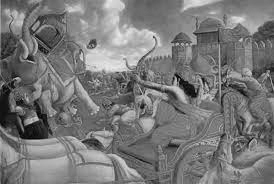When Akrura comes to Gokula and invites Krishna to participate in the dhanuryāga, he takes leave of his foster-parents Yashoda and Nandagopa, and goes off with Akrura taking his brother Balarama with him. Even as the brothers enter the city of Mathura, they meet the royal washerman. Krishna and Balarama were honourable guests in Mathura but when they requested the washerman for a pair of clothes, he refused and abused them. Krishna immediately revolts. It didn’t matter who the other person was. They say that democracy needs eternal vigilance. We see that in Krishna’s life.
While he severely dealt with the washerman and suchlike evil people, he was helpful to the helpless and to the noble. In the same episode of entering the city of Mathura, he helps one of the elderly maid-servants of the king, who was hunchbacked and weak. Setting the crooked straight—at all levels—seems to have been Krishna’s motto. There’s no point in saying, “Oh it’s crooked.” One has to go and set it straight. That is what Krishna did.
Kamsa tried to get Krishna killed by sending his finest wrestlers. Krishna destroyed them. He didn’t wait for Kamsa to recover from the series of shocks – death of the washerman, death of the elephant, death of the wrestlers, breaking of the bow in the dhanuryāga; he swiftly killed Kamsa, thus creating a powerful impact in the minds of the common people who had been harassed by their king. As soon as he created favourable public opinion, he acted immediately; he struck while the iron was hot.
The Bhāgavata has a beautiful verse about how Krishna was seen by different people:
When Krishna entered the arena with his brother, he appeared to be
a bolt of lightning to the wrestlers, a great hero to men,
cupid to women, a relative to the cowherds;
a punisher to kings, a child to his parents,
death to Kamsa, the king of the Bhojas;
a supreme force to the unlettered,
the ultimate truth to the yogis,
and a great deity to the Vrishnis.मल्लानाम् अशनिः नृणां नरवरः स्त्रीणां स्मरो मूर्तिमान्
गोपानां स्वजनोऽसतां क्षितिभुजां शास्ता स्वपित्रोः शिशुः।
मृत्युर्भोजपतेर्विराडविदुषां तत्त्वं परं योगिनां
वृष्णीनां परदेवतेति विदितो रङ्गं गतः साग्रजः॥
Bhāgavata-purāṇa 10.43.17
Almost single-handedly he gave deliverance to the Bhojas. The same people who hailed him as a hero and a deity were suddenly worried when Jarasandha attacked. They felt that he is the one to blame. Vikadru, one of the elders, said “At least under Kamsa’s tyrannical rule, we were alive. Now we might be killed!” Public memory is always short. Krishna has to start from scratch. And so he did. He was never tired or bowed down by situations. He just went ahead.
There are several instances in the epic when Krishna has called out the mistakes of different people. He calls out the mistakes of Duryodhana and Dhritarashtra and also those of Yudhistira and Arjuna. But he has never proclaimed that a certain society or a certain people are evil. The reason being that society doesn’t have its own identity. It behaves in the way that the people behave at that place and at that time.
When he comes to Mathura and begins consolidating the Yadavas, that is also the time he first meets his parents after birth. He never complains that his parents left him at birth or that he was robbed of his mother’s love.
It is such a fascinating thing to contrast this with Karna. There is such a huge difference in the way they deal with similar situations. Karna forever whines about his mother abandoning him at birth but Krishna takes it in his stride. In both instances, the child was sent away with good intention. Devaki and Vasudeva sent away Krishna because Kamsa was going to kill that child. Kunti sent away Karna because she did not want him to be abused by society for not having a father. She felt that he would lead a good life if someone else brought him up. As is well-known, she puts many ornaments and precious stones in the basket that carries Karna away, hoping that the finder of the baby will take care of it at least for the sake of the riches. The reason why Karna felt so bad about it was because he was not a public figure. He was a self-serving individual. He was a servant of his ego, not of society. It was all about him and his friendship with Duryodhana, not about dharma or society.
Krishna’s thinking was totally different. Are only these two my parents? All elders are my parents. All the younger ones are my brothers and sisters. He connected himself with the world. Thus he could share his love with everyone. The intense love he had for the world was infinite. Like the famous invocatory mantra in the Upaniṣads, “Pūrṇamadaḥ pūrṇamidam...,” he led his life, filled with infinite love.
What is further remarkable is that Krishna was able to develop this universal thinking at such a young age and without anyone mentoring him or guiding him.
Krishna’s mind was constantly filled with thoughts of society to the extent that he didn’t worry about his studies or his career. He didn’t go behind improving his bio-data.
Rama had a solid education in a methodical way. But Krishna learnt things here and there, in bits and pieces. What he had was the vision and the power to grasp the underlying philosophy of things. A public figure need not be a specialist but he has to be a visionary. Deep knowledge in a subject can make someone a good teacher perhaps but not a leader, not a statesman. Krishna had grasped the underlying philosophy of various subjects. It is said that it took him only sixty-four days for him to learn everything. Of course, it’s impossible to learn all subjects in a matter of months, but the spirit behind that statement is simply that he was able to get to the root of the subject, the philosophy governing it rather than knowing the technical details. Manu says,
“Those who read texts are greater than the ignorant,
those who remember texts are better than mere readers
those who understand the meaning are greater than those who remember
those who practice the teachings are greater than those who understand”अज्ञेभ्यो ग्रन्थिनः श्रेष्ठा
ग्रन्थिभ्यो धारिणो वराः।
धारिभ्यो ज्ञानिनः श्रेष्ठा
ज्ञानिभ्यो व्यवसायिनः॥
Manusmṛti 12.103
A statesman should know about things in general; he or she need not get into the minute details. People like them have much grander things to accomplish.
Krishna’s detachment and self-effacement help him go beyond the vagaries of public life. In the Vibhūtiyoga of the Bhagavad-Gītā, he identifies himself with the best of everything. It might be good or bad, but it has reached eminence and he associates himself with that. A public figure has to accept the good and the bad; he has to swim in the sacred waters as well as wade past the muck of the sewers. That is the way of Krishna as well.
Rama moved with everyone with respect and affection but he doesn’t become intimate with anyone where he can freely take liberties. It is also not easy for people to take liberty with Rama. The renowned poet-composer Tyagaraja says in his Charukeshi kriti, Āḍamoḍigaladā – Rama didn’t speak directly even with Hanuman, the embodiment of eloquence and possessed with the brilliance of Shiva himself. He praises the words of Hanuman in front of Lakshmana and asks him to talk with Hanuman. But Krishna is free with everyone. He easily makes friends but he is unattached. He wants to know about everyone. He went to the seer Sandipani to learn the Rigveda but he befriends Kuchela who was learning the Samaveda. Although he was a student from a different section, he became fast friends with Krishna. It is important for a public figure to be interested in all aspects of society, in all people.
When a leader rallies people together for a cause, he must motivate them. This is crucial. In the realm of family, motivation is possible only to a limited extent. Parents can motivate their children to work hard and after a while it is often unnecessary. That is not, however, the case with society. What seems artificial at home may become natural in society. On a public platform a powerful speech replete with imagery and slogans succeeds but at home, it will seem strange. The formal language on stage is not used at home; it is the colloquial and informal version of the language.
In the Rāmāyaṇa, we don’t see Rama motivating any person or a crowd for a cause. In fact, Lakshmana motivates Rama at one point saying “उत्साहो बलवान् आर्य नास्ति उत्साहात्परं बलम्” (Kiṣkindhākāṇḍa 1.121). But Krishna speaks so many inspiring words at so many instances. The Bhagavad-Gītā is a prime example.
Krishna does his best, forever trying to solve the problems around him. He unites the Yadavas and builds an army against Jarasandha, but he fails. In the Rāmāyaṇa, Rama’s failures are fewer. Shiva’s failures are almost non-existent. The reason is simple. At the level of the individual, we work to our strengths while being aware of our limitations. The factors that can be controlled are many. The results are therefore predictable to a great extent. At the level of family, it’s slightly more complicated. But at the level of society, there are so many variables. For instance, an individual might build one or two or three houses. How much can go wrong there? But a contractor builds hundreds and thousands of buildings. The chances of error there are much higher. The probability of failure in a large-scale undertaking is higher.
Krishna drove Jarasandha away but he attacked a second time. Again, he drove him away but he attacked a third time. Krishna decided that it was not a good strategy. Moreoever, the Yadavas were already pointing fingers at Krishna saying, “You are the reason why Jarasandha is attacking us!” A person who is working for the sake of the larger good, a public figure, has to respect the words of the people. When the Yadavas lamented that they were unable to bear the onslaught of Jarasandha, Krishna decided to banish himself from the country. He went into exile. Later, when the Yadavas were crushed, they ran back to him for help. Krishna came and helped them without a frown on his face. When the society behaves badly towards a public figure, he cannot take offence and when the society asks for his help, he should wholeheartedly support. One can only imagine how difficult this is!
Krishna once again began uniting the Yadavas and consolidating their position. They were successful in driving Jarasandha back once again but Krishna knew that this was not a long-term strategy. Hawks like Jarasandha are only interested in war; their sole aim is harassing other people. Jarasandha had an ally in Kalayavana, who attacked the Yadavas from the western frontier. Kalayavana was half-Indian, half-Greek (there are some stories that he was the son of a Yadava purohita and Yavana lady) who ruled a kingdom beyond Gandhara.
The Yadavas were not war-mongering people. They were interested in progress, in stability. So Krishna suggests that they move to Dvaravati. He tells the Yadavas that they need a safer place where they can develop culturally and financially. Many of younger leaders among the Yadavas oppose Krishna calling him a coward. But he was willing to take the dubious title of a coward if it was going to help his people. From the banks of the Yamuna, he took them to Dvaravati, which is at the western tip of India. What a massive exodus! How many people, how many different views and opinions! But he undertook the task. He was willing to do anything to help people.
In a family, if we take care of the established values, it is often sufficient. The undertakings of Rama are on those lines. In Krishna’s case, he is the harbinger of new values. He is ushering in a new era. He could not afford to ride the horse of established values because societies change in diverse, unpredictable ways.
After taking all the Yadavas to Dvaravati and establishing them, he ensured stability and good governance. In spite of that, did they behave in a manner befitting Krishna’s vision? No. They destroyed themselves. But Krishna was undeterred.
To help the building of Indraprastha, Krishna sent a lot of materials and riches to the Pandavas. Would the Yadavas have agreed to part with their wealth so easily? It would have taken a lot of convincing on the part of Krishna. But he ensured that it happened. He spoke gently, he spoke cleverly; he drove fear into their hearts, he tempted them, he soothed them. Who can do these things? A straightforward person cannot. A crooked person can, but why will he do good? What is the way? This is why we need a Krishna. An individual, who is courageous and strong, learned and composed, selfless and detached. When such a person does anything, it will be fine. There is no fear of straying on the path of dharma.
To be continued.
This serialized article has been translated by Hari Ravikumar from the author’s Kannada lecture held at the Gokhale Institute of Public Affairs, Bangalore in 2009.



















































